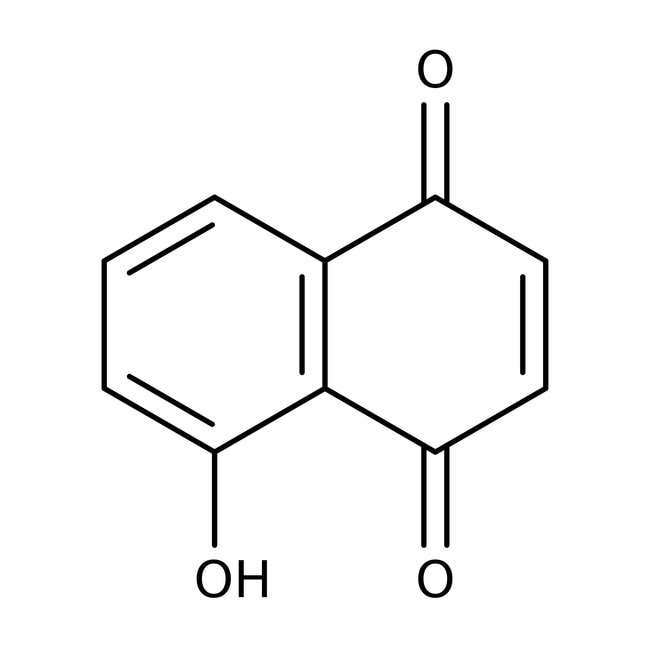Search Thermo Fisher Scientific
Thermo Scientific Chemicals
5-Hydroxy-1,4-naphthoquinone, 99%, Thermo Scientific Chemicals
Catalog number: H28343.06
5 g, Each



Thermo Scientific Chemicals
5-Hydroxy-1,4-naphthoquinone, 99%, Thermo Scientific Chemicals
Catalog number: H28343.06
5 g, Each
Quantity
Catalog number: H28343.06
also known as H28343-06
Price (USD)
166.00
Each
Quantity
-
Have Questions?
Chemical Identifiers
CAS
481-39-0
IUPAC Name
5-hydroxy-1,4-dihydronaphthalene-1,4-dione
Molecular Formula
C10H6O3
InChI Key
KQPYUDDGWXQXHS-UHFFFAOYSA-N
SMILES
OC1=CC=CC2=C1C(=O)C=CC2=O
Specifications
Appearance (Color)
Orange to brown
Form
Powder
Assay (HPLC)
≥98.5%
Identification (FTIR)
Conforms
Description
5-Hydroxy-1,4-naphthoquinone is used as a natural dye in cloth, fabrics, wool and ink. It is a coloring agent for food and cosmetics. It is involved in the synthesis of poly(hydroxyl-1,4-naphthoquinone) stabilized gold nanoparticles (AuNQ NPs), which is used for nonenzymatic electrochemical detection of glucose.
This Thermo Scientific Chemicals brand product was originally part of the Alfa Aesar product portfolio. Some documentation and label information may refer to the legacy brand. The original Alfa Aesar product / item code or SKU reference has not changed as a part of the brand transition to Thermo Scientific Chemicals.
Applications
5-Hydroxy-1,4-naphthoquinone is used as a natural dye in cloth, fabrics, wool and ink. It is a coloring agent for food and cosmetics. It is involved in the synthesis of poly(hydroxyl-1,4-naphthoquinone) stabilized gold nanoparticles (AuNQ NPs), which is used for nonenzymatic electrochemical detection of glucose.
Solubility
Soluble in alcohol, chloroform, dimethylsulfoxide, ether and aqueous solution of alkalies. Slightly soluble in water.
Notes
Light sensitive. Incompatible with strong bases, strong reducing agents and strong oxidizing agents.
5-Hydroxy-1,4-naphthoquinone is used as a natural dye in cloth, fabrics, wool and ink. It is a coloring agent for food and cosmetics. It is involved in the synthesis of poly(hydroxyl-1,4-naphthoquinone) stabilized gold nanoparticles (AuNQ NPs), which is used for nonenzymatic electrochemical detection of glucose.
Solubility
Soluble in alcohol, chloroform, dimethylsulfoxide, ether and aqueous solution of alkalies. Slightly soluble in water.
Notes
Light sensitive. Incompatible with strong bases, strong reducing agents and strong oxidizing agents.
RUO – Research Use Only
Figures
Documents & Downloads
Certificates
Search by lot number or partial lot number
Frequently asked questions (FAQs)
Citations & References
Search citations by name, author, journal title or abstract text